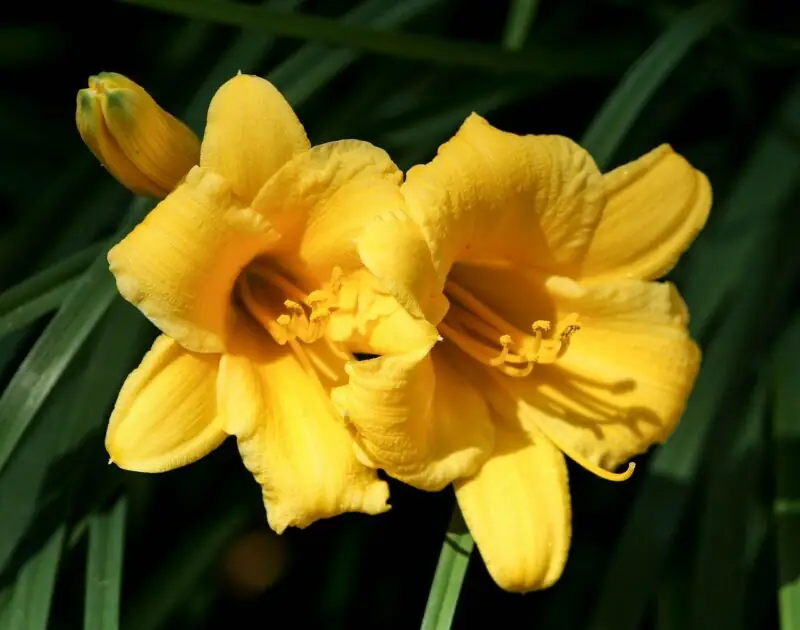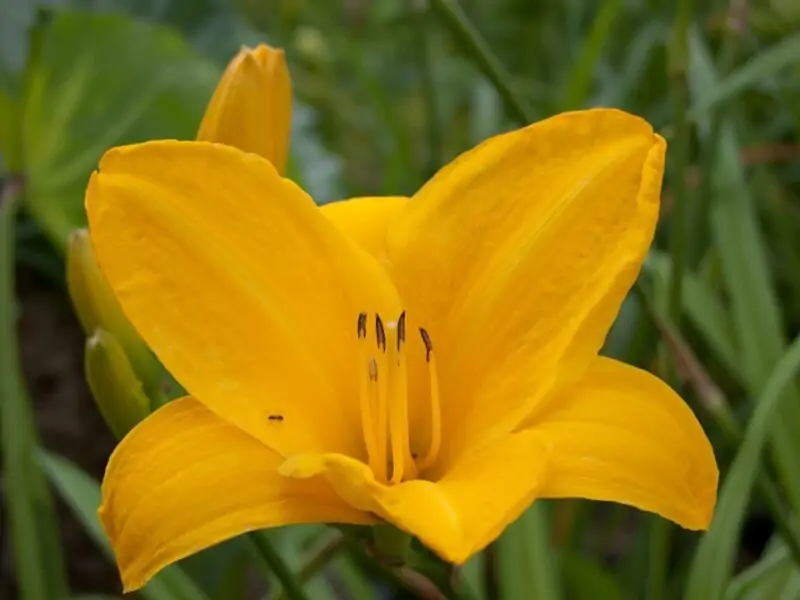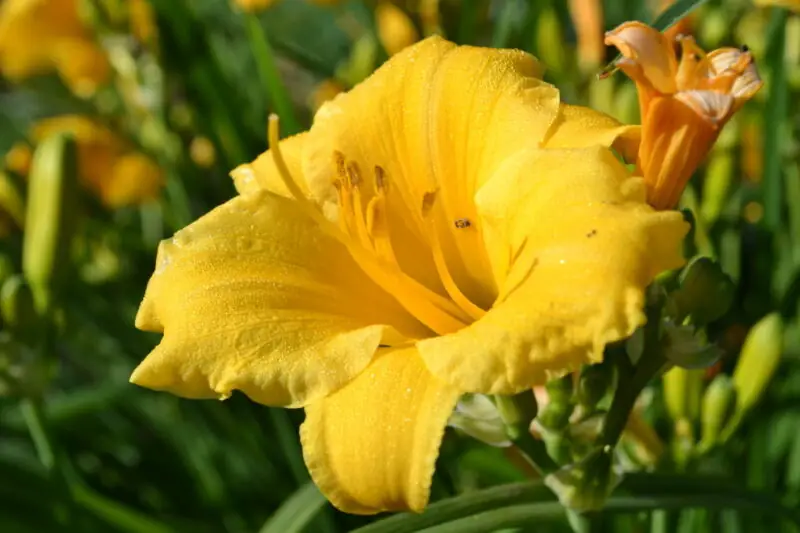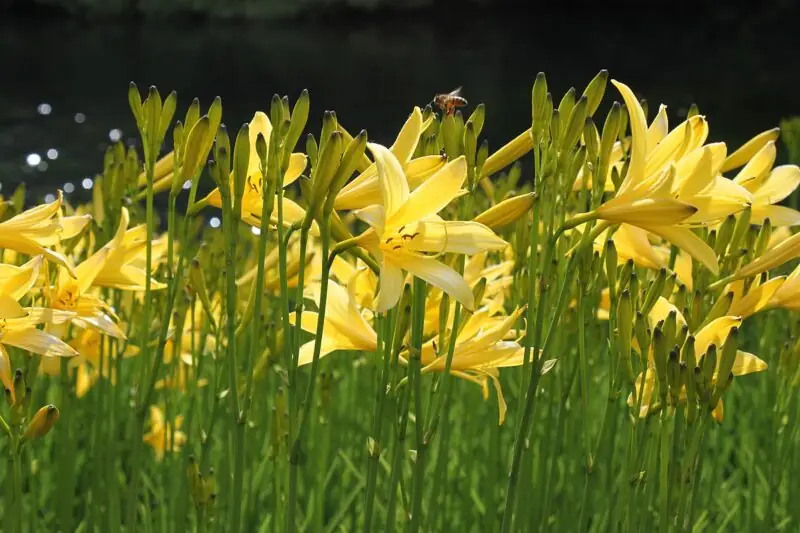Reblooming Yellow Daylilies: The Vibrant Hemerocallis Lilioasphodelus, a Daylily Like No Other

Welcome to the sunny world of yellow daylilies, the perennial favorites of many gardeners. These radiant beauties, also known as Hemerocallis, are an iconic addition to any garden, boasting a variety of cultivars with bright yellow blooms that radiate warmth and joy. With their ability to thrive in a range of climates and resist common plant diseases, yellow daylilies are truly a gardener’s delight.
Understanding Daylilies

What is a Daylily?
A daylily is a flowering plant in the genus Hemerocallis. The name “daylily” reflects the plant’s unique characteristic—each flower blooms for just a single day. But don’t let this make you think these plants are short-lived. A single daylily plant produces many flower buds that open on different days, creating a long-lasting spectacle throughout the growing season. Daylilies are known for their hardiness and adaptability, able to flourish in various climates and soils.
The Perennial Nature of Daylilies
Daylilies are perennials, meaning they live for more than two years, blooming over and over throughout their lifetime. They show their green foliage early in the springtime, and their colorful flowers bloom from early summer through the early fall. The plants go dormant during the colder months, but they’ll burst back into life when the warmer months return.
Hemerocallis Lilioasphodelus: The Original Yellow Daylily
This cultivar, also known as the lemon daylily, is one of the original yellow daylilies. It boasts lemon-yellow, trumpet-shaped flowers that emit a subtle fragrance. While its bloom time is shorter compared to modern hybrids, its historical significance and charm make it a classic choice for enthusiasts.
Daylilies Versus Day Lilies: Clearing the Confusion
While the names are similar, “daylilies” (one word) and “day lilies” (two words) refer to different plants. Daylilies belong to the Hemerocallis genus and are not true lilies. “Day lily,” on the other hand, is a common name for plants in the Lilium genus, the true lilies. Remember, despite the confusion, our star of the show is the Hemerocallis – the daylily!
The Allure of Yellow Daylilies
Symbolism and Importance of the Color Yellow
Yellow is a color of happiness, optimism, and enlightenment. Yellow flowers, including daylilies, often symbolize friendship and joy. A garden full of yellow daylilies can lift spirits, spread positivity, and make every day feel like a sunny day.
Why Choose Yellow Daylilies for Your Garden?
Yellow daylilies are fantastic for brightening up your garden. Their sunny hues contrast beautifully with dark green foliage, and they blend harmoniously with other colored flowers. Easy to grow and maintain, these plants are perfect for both novice gardeners and seasoned green thumbs.
Yellow Daylilies: Bringing Sunshine to Your Garden
There’s nothing quite like the sight of yellow daylilies in full bloom. These bright yellow flowers can transform your outdoor space into a sunny sanctuary. Whether they’re serving as a striking focal point, an edge plant, or ground cover, yellow daylilies guarantee a vibrant display that can make any garden a cheerful and welcoming place.
Diverse Varieties of Yellow Daylilies

Endlesslily Yellow Daylily: A Review
The Endlesslily is a reblooming daylily that boasts buttery yellow blooms. It’s a perennial powerhouse, producing an endless stream of flowers from early summer till frost. Endlesslily loves soaking up the full sun, making it a luminous spectacle in any garden. Its adaptability to various soil conditions also ensures it can grace many gardens with its bright yellow blossoms.
Buttered Popcorn Daylily: A Sumptuous Choice
This daylily variety is a crowd-pleaser! Its large, vibrant yellow flowers look like scoops of buttered popcorn. As a reblooming variety, it showers your garden with these luscious blooms throughout the growing season. Plus, Buttered Popcorn is known for its high resistance to common daylily pests and diseases, ensuring a hassle-free gardening experience.
Banana Buds Daylily: A Unique Addition
Banana Buds is a daylily variety that’s hard to forget. Its sculpted, banana-yellow flowers with a green throat stand out in the garden, attracting hummingbirds and butterflies. Its blooms, held high on sturdy scapes above the mound of green foliage, create a stunning vertical dimension in the garden. This cultivar thrives in full sun to partial shade, making it a versatile addition to your flower beds.
Pocket Full of Gold Daylily: The Golden Bloom
If you’re seeking a small daylily variety that still packs a punch, look no further than Pocket Full of Gold. This compact daylily has tiny, gold-colored flowers that brighten up any garden nook. Despite its size, it’s a robust bloomer, producing a profusion of flowers throughout the summer. Give it a minimum of six hours of full sun, and you’ll have your very own garden treasure.
The Ever-Popular Happy Returns Daylily
Happy Returns is one of the most popular yellow daylilies around, and for a good reason. Its lemon-yellow, trumpet-shaped flowers bloom from late spring to early fall, offering a seemingly never-ending display of cheerfulness. The plant’s ability to thrive in a range of soil conditions and withstand hot climates adds to its charm. This reblooming variety will truly bring ‘happy returns’ to your garden!
Stella de Oro Daylily: The Star of the Show
The Stella de Oro daylily is a star performer. Its golden-yellow flowers bloom early and rebloom consistently until early fall. Its compact size makes it an excellent choice for small gardens or containers. With the Stella de Oro in your garden, you’ll be treated to a star-studded performance throughout the growing season.
Cadmium Yellow Daylily: A Radiant Selection
The Cadmium Yellow daylily is a sight to behold. Its intense, cadmium-yellow flowers are bell-shaped and elegantly arch on the scapes, providing a dynamic look. In addition to its radiant flowers, this daylily is prized for its semi-evergreen foliage, which adds interest to the garden even when the plant is not in bloom.
Rainbow Rhythm Tiger Swirl Daylily: A Colorful Mix
Rainbow Rhythm Tiger Swirl is a feast for the eyes. This yellow daylily variety flaunts large, yellow flowers with a distinctive pattern – they’re yellow with a prominent red eye and matching picotee edge on the petals. This dramatic daylily adds a swirl of color to your garden, and its bright blossoms can lure in hummingbirds for your viewing pleasure. Its strong stems keep the flowers upright, ensuring they don’t get lost in the crowd of foliage below.
Going Bananas Daylily: For a Fun and Lively Garden
If you’re up for something fun and lively, Going Bananas is your best bet. This yellow daylily variety is an absolute showstopper with its lemon-yellow, fragrant flowers that rebloom throughout the season. It’s easy to grow, drought tolerant, and unappealing to deer – a true gardener’s delight!
El Desperado Daylily: Bold and Daring
This daring cultivar is a fantastic choice if you’re looking to make a statement in your garden. El Desperado boasts bold, yellow flowers with a contrasting wine-purple eye, adding a dramatic splash of color to your garden. Not only is this daylily visually striking, but it’s also a strong grower, proving that beauty and strength can coexist.
Chicago Sunrise Daylily: Bright as a New Day
Let’s move on to the Chicago Sunrise daylily. As the name suggests, it brings a new dawn to any garden with its bright yellow flowers. Its strong scapes and vigorous growth habit make it a reliable performer. Whether you’re a newbie gardener or a seasoned one, you’ll appreciate the charm and resilience of this daylily.
Double Creped Gold Daylily: Twice the Charm
If you’re after a unique daylily, Double Creped Gold could be the one for you. As the name implies, it produces double flowers that have a creped texture, which gives the plant a unique and interesting look. This cultivar is a vigorous grower, showing off its sunny yellow blossoms throughout the summer months. Double Creped Gold is undeniably twice the charm!
Yellow Hornet Daylily: A Striking Choice
Yellow Hornet is a striking daylily with its large, vivid yellow flowers and contrasting green throat. This cultivar isn’t just about aesthetics, though. It’s also known for its robust nature, resisting common diseases and pests that might bother other daylilies. With its exceptional beauty and strength, Yellow Hornet can add a sting of delight to your garden.
Gold Dust Daylily: A Dusting of Sunshine
Sprinkle some sunshine in your garden with the Gold Dust daylily. It’s a smaller variety, but don’t let its size fool you. This perennial dynamo offers a flurry of golden-yellow blooms that sparkle like dusted gold. It’s resistant to common pests and diseases and is pretty tolerant of various soil conditions, making it a tough contender in the daylily world.
Mini Stella Daylily: Small but Mighty
Mini Stella proves that good things come in small packages. This miniature version of the Stella de Oro is a dynamite, offering loads of golden-yellow blooms from spring to fall. It’s an excellent choice for gardeners dealing with limited space but still want a powerful display of vibrant daylilies.
Lake Norman Sunrise Daylily: A Breathtaking Bloom
If you’re after something truly breathtaking, consider the Lake Norman Sunrise daylily. Its large, bright yellow flowers add a radiant touch to any garden. Not only does it have stunning blooms, but it’s also a reblooming variety, offering multiple waves of flowers throughout the growing season. With proper care, this daylily can serve as the perfect focal point in your garden.
Mary Todd Daylily: Classy and Elegant
Classy and elegant, Mary Todd daylily brings timeless beauty to your garden. This cultivar produces large, frilly bright yellow flowers that can captivate anyone’s eyes. Mary Todd is a strong grower, too. Its sturdy stems and resistance to common diseases make it a low-maintenance addition to your flower garden.
Big Time Happy Daylily: A Joyful Bloom
Big Time Happy is all about spreading joy. Its bright yellow blooms are guaranteed to bring a smile to your face every time you glance at them. This variety is a reblooming daylily, ensuring a steady supply of joyful blossoms throughout the growing season. It’s a happy-go-lucky plant that’s easy to care for, making it an absolute gem for any gardener.
Shamrock Dew Stamile Daylily: A Refreshing Selection
Shamrock Dew Stamile is a unique cultivar, distinguished by its clear, lemon-yellow flowers. The blooms are large and fragrant, making them a sight (and scent) to behold. This daylily is resistant to most pests and diseases, and its early fall blossoms provide a refreshing sight when other plants might be winding down.
Erin Lea Daylily: Beautiful and Captivating
Erin Lea daylily will make you fall in love with its beauty. It bears huge, bright yellow flowers, presenting a captivating display. It’s a vigorous grower, with strong stems and lush, dark green foliage that enhances the radiance of its blooms. Its resistant nature helps it stand strong against pests and diseases, ensuring your garden remains a sight to behold.
Saffron Skye Daylily: A Heavenly Bloom
Step into a heavenly garden with the Saffron Skye daylily. It’s a beautiful reblooming variety that showcases lemon-yellow flowers. Its blooms are large and fragrant, making it an appealing addition to any garden. Saffron Skye is resistant to pests and diseases, and its blooms last longer than many plants, extending the flowering period into late summer and early fall.
Chicago Gold Coast Daylily: Glamorous and Stylish
The Chicago Gold Coast daylily is all about glamour and style. It bears large, ruffled bright yellow flowers that command attention. This daylily is a strong grower, with tall scapes that display the flowers above the foliage. Its easy-to-grow nature and resistance to common pests make it a stylish and practical addition to your flower garden.
Creped Gold Daylily: A Touch of Class
Last but definitely not least is the Creped Gold daylily. It brings a touch of class to your garden with its large, creped bright yellow flowers. This daylily variety is a strong grower, boasting robust foliage and numerous scapes. Creped Gold is resistant to pests and diseases, and its stunning blooms can add a touch of elegance to any garden.
Caring for Your Yellow Daylilies

Planting and Pruning Your Daylily Plants
Ready to bring some sunshine into your garden with yellow daylilies? Great! Here’s what you need to know. These flowers love their sunbaths, needing a minimum of six hours of full sun. So pick a sunny spot in your garden, improve the soil with some organic matter, and you’re good to go!
When it comes to pruning, consider it a haircut for your plants. It helps them look their best and encourages new growth. For daylilies, this involves removing spent blooms and cutting back the foliage to about 6 inches in late fall.
Essential Daylily Care Tips for Optimal Blooming
To help your yellow daylilies strut their stuff all season long, regular care is key. One key aspect of daylily care is thorough watering. These plants might not be drama queens when it comes to drought, but they sure appreciate a good drink, especially during the warmer months. However, balance is important, as too much water could lead to root rot. So ensure the soil drains well to keep your daylilies happy.
Moreover, to support the plant’s prolific blooming, consider feeding them a balanced fertilizer in early spring. This will not only promote strong stems and many blooms but also give the plant a healthy kickstart for the growing season.
Also, don’t forget about deadheading – the act of removing spent blooms. It’s like giving your daylilies a little makeover every time a flower wilts. This helps to redirect the plant’s energy from producing seeds to creating more of those brilliant flowers that last for just one day but leave a lasting impression!
Seasonal Care for Your Yellow Daylilies
If you think of your garden as a year-round party, then you’ve got to keep the decorations fresh according to the season. Come springtime, when new growth begins, it’s time to clean up any dead leaves and prepare the soil for the bustling season ahead. A little compost or organic matter can go a long way in improving soil fertility and moisture retention.
As summer rolls in, it’s time to step up the watering and watch your daylilies come alive. Remember to remove spent blooms to encourage the plant to produce more flowers. But once the curtain of autumn starts to fall, cut back the foliage to a height of about six inches. This helps the plant to hibernate peacefully during winter, preparing it for a grand revival come next spring!
Dealing with Common Daylily Pests and Diseases
Even the sunniest daylily isn’t immune to a few clouds. Pests like aphids and spider mites can be a nuisance, and diseases like daylily rust and leaf streak can pose threats. Regular checks can help catch these issues early and keep your daylilies in the pink (or should I say, yellow?) of health. Remember, a healthy plant is the best defense against pests and diseases.
FAQs
Daylilies, true to their name, bloom for a day. But don’t let that discourage you. These plants are getting ready for their next act, and you’ll see a new flower unfurling almost every day throughout the growing season. Talk about a daily dose of sunshine!
Want to get the most out of your daylilies? Deadhead them! Removing spent blooms encourages the plant to produce more flowers. Also, a dose of balanced fertilizer in the spring helps set the stage for a fruitful growing season.
Yellow daylilies are indeed toxic to pets, particularly cats. Ingesting any part of the plant can lead to kidney failure in felines. So, if you have furry friends roaming around, it might be a good idea to rethink planting daylilies or keep them out of paw’s reach.
Yellow daylilies are like those social butterflies who love the spotlight. They prefer full sun to partial shade. Although they can tolerate some shade, too much can impact their blooming. So, for the brightest and happiest daylilies, plant them where they can bask in the glory of the sun.
Daylilies propagate through division. This means you split the clump of the plant into smaller sections, each with a portion of the root system, and then replant them. It’s like sharing pieces of a sunshine cake! This is best done in early spring or after the flowering season in late summer to early fall. But remember, each division should have at least two or three scapes for the best results.
Oh, and a quick tip: A thorough watering after division can help the plants settle in their new spots. Trust me, they’ll thank you with a bundle of bright blooms in the next growing season.
Conclusion
If you’ve made it this far, congratulations! You’re now armed with all the know-how to cultivate your very own sunshine garden, thanks to the yellow daylily. From understanding their nature to exploring the diverse varieties and mastering their care, you’ve journeyed through the bright world of this sunny perennial.